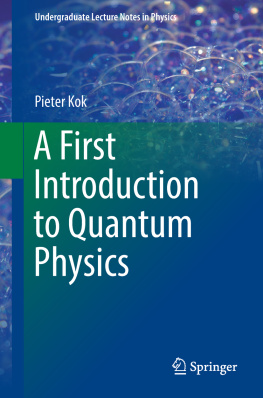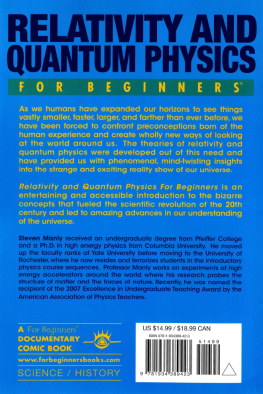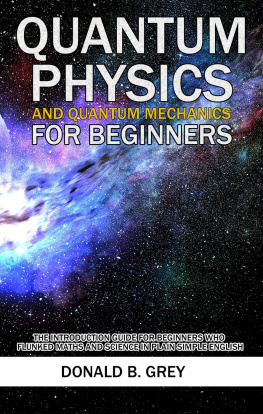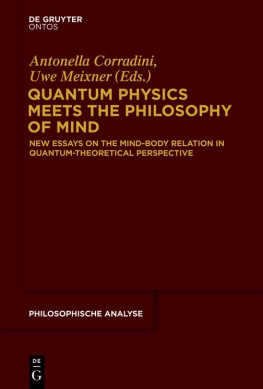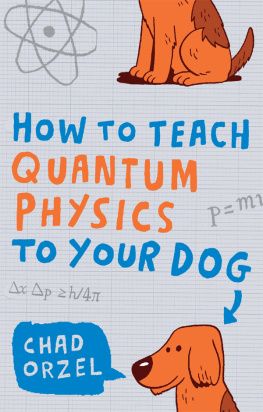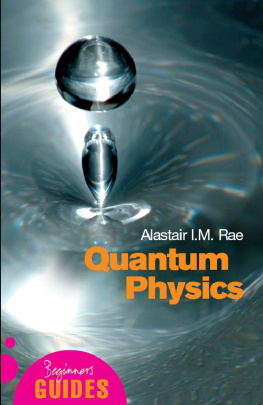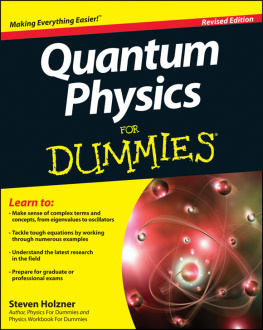Pieter Kok - A First Introduction to Quantum Physics
Here you can read online Pieter Kok - A First Introduction to Quantum Physics full text of the book (entire story) in english for free. Download pdf and epub, get meaning, cover and reviews about this ebook. year: 0, publisher: Springer International Publishing, genre: Romance novel. Description of the work, (preface) as well as reviews are available. Best literature library LitArk.com created for fans of good reading and offers a wide selection of genres:
Romance novel
Science fiction
Adventure
Detective
Science
History
Home and family
Prose
Art
Politics
Computer
Non-fiction
Religion
Business
Children
Humor
Choose a favorite category and find really read worthwhile books. Enjoy immersion in the world of imagination, feel the emotions of the characters or learn something new for yourself, make an fascinating discovery.
- Book:A First Introduction to Quantum Physics
- Author:
- Publisher:Springer International Publishing
- Genre:
- Year:0
- Rating:4 / 5
- Favourites:Add to favourites
- Your mark:
- 80
- 1
- 2
- 3
- 4
- 5
A First Introduction to Quantum Physics: summary, description and annotation
We offer to read an annotation, description, summary or preface (depends on what the author of the book "A First Introduction to Quantum Physics" wrote himself). If you haven't found the necessary information about the book — write in the comments, we will try to find it.
A First Introduction to Quantum Physics — read online for free the complete book (whole text) full work
Below is the text of the book, divided by pages. System saving the place of the last page read, allows you to conveniently read the book "A First Introduction to Quantum Physics" online for free, without having to search again every time where you left off. Put a bookmark, and you can go to the page where you finished reading at any time.
Font size:
Interval:
Bookmark:
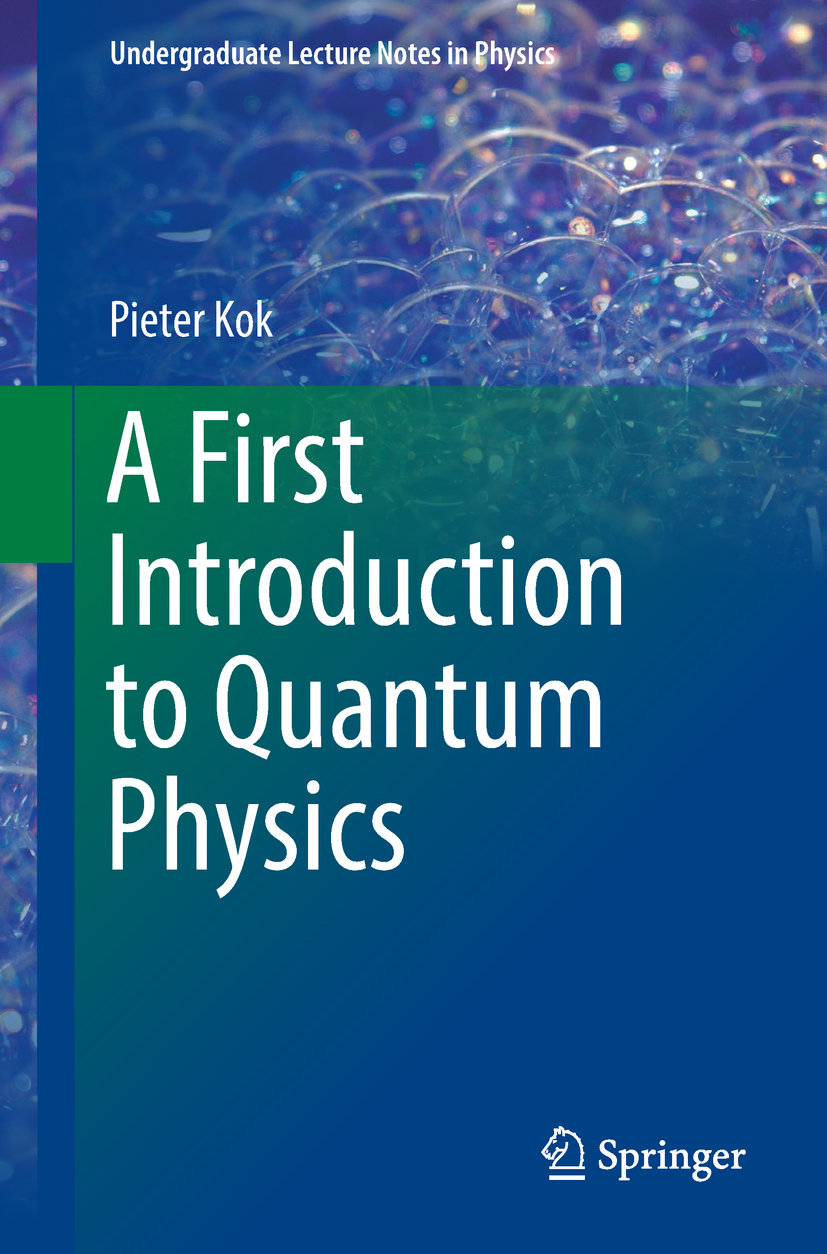
Undergraduate Lecture Notes in Physics (ULNP) publishes authoritative texts covering topics throughout pure and applied physics. Each title in the series is suitable as a basis for undergraduate instruction, typically containing practice problems, worked examples, chapter summaries, and suggestions for further reading.
An exceptionally clear and concise treatment of a standard undergraduate subject.
A solid undergraduate-level introduction to a graduate, advanced, or non-standard subject.
A novel perspective or an unusual approach to teaching a subject.
ULNP especially encourages new, original, and idiosyncratic approaches to physics teaching at the undergraduate level.
The purpose of ULNP is to provide intriguing, absorbing books that will continue to be the readers preferred reference throughout their academic career.
Series editors
Neil Ashby
University of Colorado, Boulder, CO, USA
William Brantley
Department of Physics, Furman University, Greenville, SC, USA
Matthew Deady
Physics Program, Bard College, Annandale-on-Hudson, NY, USA
Michael Fowler
Department of Physics, University of Virginia, Charlottesville, VA, USA
Morten Hjorth-Jensen
Department of Physics, University of Oslo, Oslo, Norway
Michael Inglis
Department of Physical Sciences, SUNY Suffolk County Community College, Selden, NY, USA
More information about this series at http://www.springer.com/series/8917

This Springer imprint is published by the registered company Springer International Publishing AG part of Springer Nature
The registered company address is: Gewerbestrasse 11, 6330 Cham, Switzerland
Quantum mechanics is one of the crowning achievements of human thought. There is no theory that is more successful in predicting phenomena over such a wide range of situationsand with such accuracythan quantum mechanics. From the basic principles of chemistry to the working of the semiconductors in your mobile phone, and from the Big Bang to atomic clocks, quantum mechanics comes up with the goods. At the same time, we still have trouble pinpointing exactly what the theory tells us about nature. Quantum mechanics is hard, but perhaps not as hard as you think. Let us compare it to another great theory of physics: electromagnetism.
When we teach electricity and magnetism in school and university, we start with simple problems involving point charges and line currents. We introduce Coulombs law, the law of Biot and Savart, the Lorentz force, and so on. After working through some of the most important consequences of these laws, we finally arrive at Maxwells equations. Advanced courses in electrodynamics then take over and explore the consequences of this unification, treating such topics as waveguides, gauge invariance, relativity. The pedagogical route is going from the simple, tangible problems to the general and abstract theory. You need to know quite a bit of electromagnetism and vector calculus before you can appreciate the beauty of Maxwells equations.
The situation in teaching quantum mechanics is generally quite different. Instead of simple experimentally motivated problems, a first course in quantum mechanics often takes a historical approach, describing Plancks solution of black-body radiation, Einsteins explanation of the photoelectric effect, and Bohrs model for the atom from 1913. This is then followed by the introduction of the Schrdinger equation. The problem is that appreciating Schrdingers equation requires a degree of familiarity with the corresponding classical solutions that most students do not yet have at this stage. As a result, many drown in the mathematics of solving the Schrdinger equation and never come to appreciate the subtle and counterintuitive aspects of quantum mechanics as a fundamental theory of nature.
It does not have to be like this. We can develop the core principles of quantum mechanics based on very simple experiments and without requiring much prior mathematical knowledge. By exploring idealised behaviour of photons in interferometers, electron spins in magnetic fields, and the interaction of simple two-level atoms with light, we can put our finger quite precisely on the strange, puzzling, and wonderful aspects of nature as described by quantum mechanics. We can then illustrate the theory with modern applications such as gravitational wave detection, magnetic resonance imaging, atomic clocks, quantum computing and teleportation, scanning tunnelling microscopy, and precision measurements.
Another reason to write this book was to make use of the wonderful possibilities that are offered by new media. Physics is an experimental science, and seeing how systems behave in interactive figures when you nudge them in the right way hopefully gives the reader an immediate connection between the experiments and the physical principles behind them. That is why I have included many interactive elements to accompany the text, which are available online. I firmly believe that replacing static figures on a page with interactive and animated content can be a great pedagogical tool when used correctly.
Font size:
Interval:
Bookmark:
Similar books «A First Introduction to Quantum Physics»
Look at similar books to A First Introduction to Quantum Physics. We have selected literature similar in name and meaning in the hope of providing readers with more options to find new, interesting, not yet read works.
Discussion, reviews of the book A First Introduction to Quantum Physics and just readers' own opinions. Leave your comments, write what you think about the work, its meaning or the main characters. Specify what exactly you liked and what you didn't like, and why you think so.

